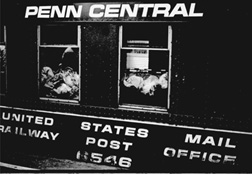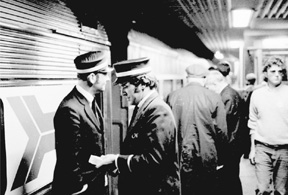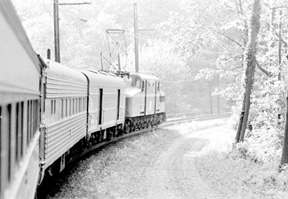Amtrak
Under the Gunn
 By
Guy Span
By
Guy Span
Railroad passenger trains were in
trouble years before they were nationalized. In 1950, the larger
railroads operated some 147,511 passenger route miles. By 1968, that
fell to 58,130. Operating losses were huge. On the famed California
Zephyr domeliner service between Chicago and San Francisco losses,
rose to $2.6 million in 1969 on just the Western Pacific portion
(with reasonably full passenger loadings). The Seaboard Coastline
alone had $12 million dollars of out-of-pocket losses relating to
passenger service in 1967.
The real problem was high labor
costs for railroads and dwindling ridership from cheaper or faster
alternatives. But even when the trains were full, they lost money.
In short, one wonders how private passenger trains hung on as long
as they did.
The answer is the United States
government. The U.S. Post Office paid to have pre-sorted mail move
in high-speed express cars on the head end of passenger trains.
Railway Post Office (RPO) cars also carried mail workers who sorted
en route, dropping off and picking up mailbags on the fly. This
amounted to millions in revenue for the railroads and that helped
offset (but not eliminate) passenger losses. Most railroads
continued quality passenger service primarily as public relations.
Great Northern Railway President John Budd said it best in TRAINS
magazine in 1969 when he noted, " The world judges the railways
by their passenger service. If this is the window through which we
are viewed, we must wash it and shine it, or cover it with a dark
shade."
 But
real trouble for passenger trains arrived around 1966, when the US
Post Office introduced a harmless little mail expediter – the Zip
Code. The Zip Code would lead to more pre-sorted mail and suburban
sorting centers. Instead of sorting your mail at the local office
and forwarding out-of-town mail to the downtown branch, all mail
would be moved to a central sorting station outside of town (and not
adjacent to a railway). Local mail would be returned and out-of-town
mail would be either trucked or flown to destination. The large
central downtown post offices next to the railway stations were
closed as sorting centers. Airmail stopped costing extra.
But
real trouble for passenger trains arrived around 1966, when the US
Post Office introduced a harmless little mail expediter – the Zip
Code. The Zip Code would lead to more pre-sorted mail and suburban
sorting centers. Instead of sorting your mail at the local office
and forwarding out-of-town mail to the downtown branch, all mail
would be moved to a central sorting station outside of town (and not
adjacent to a railway). Local mail would be returned and out-of-town
mail would be either trucked or flown to destination. The large
central downtown post offices next to the railway stations were
closed as sorting centers. Airmail stopped costing extra.
Suddenly, the railroad passenger
trains were bereft of their head end revenue and the losses became
staggering. However, in order to eliminate a passenger train, a
railroad would have to apply to a government agency, the Interstate
Commerce Commission (ICC), for approval. This became a hot-button
political issue, as people, even those who didn’t ride the train,
didn’t want to lose their rail service. The ICC train-off petition
became difficult to achieve and the losses continued.
In part, this led to the largest
rail bankruptcy of all time – the Penn Central, which ran about 35
percent of passenger trains in America (by frequency). The
government then turned to the Department of Transportation for a
solution. In 1971, they came up with a short-term fix, originally
called Railpax, and formally known as the National Railroad
Passenger Corporation (NRPC).
 Here’s
how it worked: The railroad could join and buy shares of the NRPC by
paying its 1969 full year out-of-pocket passenger loss. In turn, the
NRPC would relieve the railroad from operating all passenger trains
without ICC petitions and would pay a fixed access fee if it decided
to operate passenger trains over that railroad’s lines. Later,
NRPC would decide which passenger cars and engines it would buy from
the contributing railroads. The government would throw in $40
million (for its shares) and fund the losses (if any) until 1975
when the whole thing would be re-evaluated. In short, what the
railroads were not allowed to do to save themselves, the government
could do in the name of saving passenger trains. The fact that
another branch of government accelerated this mess just adds to the
irony.
Here’s
how it worked: The railroad could join and buy shares of the NRPC by
paying its 1969 full year out-of-pocket passenger loss. In turn, the
NRPC would relieve the railroad from operating all passenger trains
without ICC petitions and would pay a fixed access fee if it decided
to operate passenger trains over that railroad’s lines. Later,
NRPC would decide which passenger cars and engines it would buy from
the contributing railroads. The government would throw in $40
million (for its shares) and fund the losses (if any) until 1975
when the whole thing would be re-evaluated. In short, what the
railroads were not allowed to do to save themselves, the government
could do in the name of saving passenger trains. The fact that
another branch of government accelerated this mess just adds to the
irony.
Railroads not electing to join had
to run their passenger trains until 1973 and after that would face
the ICC for any train-off petitions. All but a handful of railroads
joined. The exceptions were interesting. Tiny Denver and Rio Grande
Western was irked because its large competitor, Union Pacific, was
not going to have its parallel mainline clogged with any passenger
trains, so they decided to continue on their own schedules, forcing
NRPC to move a train on the UP. Nearly bankrupt Rock Island couldn’t
afford the entrance fee so they waived. The Georgia Road was afraid
of losing its unusual tax-exempt status so they passed. Maverick
Southern Railway figured that the new service would be so horrible
that it would get kudos for running a superior service (they did)
and besides, maybe more people would ride (they didn’t).
On May 1, 1971, the government
sort of nationalized rail passenger service. In the course, they
changed the name from Railpax to Amtrak. Secretary of Transportation
John Volpe, in answer to critics who said it would never make money,
noted that if his department didn’t think it would work, they
wouldn’t be working so hard to save it. Volpe went on to say (in a
prediction he likely regretted), "It (Public Law 91-518) lays
the foundation for what in my opinion is destined to be the all-time
comeback in the history of American transportation." And that
set the tone for Amtrak. It was always intended to be a for-profit
organization, but profits proved elusive.
 By
1973, Amtrak was not doing well (if you consider $100 million in
losses as not doing well). It had trimmed the national rail map to a
bare minimum (16 routes) only to find that politicians made them
restore some services to another 5 routes (West Virginia, Buffalo–Chicago,
Seattle–San Diego, Los Angeles–New Orleans, Norfolk–Cincinnati).
But even with the additions, the national passenger map was shorn of
lots of service. For example, 113 million passengers were carried in
1966 and just 45 million in 1972.
By
1973, Amtrak was not doing well (if you consider $100 million in
losses as not doing well). It had trimmed the national rail map to a
bare minimum (16 routes) only to find that politicians made them
restore some services to another 5 routes (West Virginia, Buffalo–Chicago,
Seattle–San Diego, Los Angeles–New Orleans, Norfolk–Cincinnati).
But even with the additions, the national passenger map was shorn of
lots of service. For example, 113 million passengers were carried in
1966 and just 45 million in 1972.
Fast forward to the Reagan
Administration, where every year after his first year in office the
President proposed a $0 budget for Amtrak (to get rid of it) and
every year maverick Amtrak President W. Graham Claytor, Jr. would
storm Capitol Hill and round up enough cash to keep it running.
Interestingly enough, it was under the Democrat’s (Clinton)
Administration that the fiction of Amtrak’s profitability
resurfaced. Amtrak was told it could have its budget if it promised
profitability by 2001. So they dutifully promised and the government
would almost provide what was asked, but always cut the budget.
In this way, Volpe’s fiction was
maintained. The goal of profitability was just around the corner (in
2001). And when 2001 arrived, the GAO found that Amtrak had
mortgaged Penn Station, owed millions and had a capital spending
need to keep even minimum service going and no money to spend.
Amtrak’s President Warrington resigned and its survival became a
real concern. The new president, David Gunn, a maverick in his own
right, has made changes and shown no fear of going toe to toe with
anyone. When Congress threatened not to fill his admittedly
minimalist budget, he said that since he couldn’t tell which parts
of Amtrak Congress didn’t want to operate, he would just shut the
whole stinking thing down. And he nearly did, but the DOT and
Congress blinked and found enough money to keep it going.
 So
right now, Amtrak is looking hard at its loss leaders, Congress is
considering making the states contribute for service–who knows
what is in the works? Maybe a move towards overnight service
operated like cruise trains, similar to Australia’s Indian
Pacific. That service is privately operated and runs twice to three
times a week across the continent, connecting the Indian Ocean with
the Pacific. And it makes money. It’s also bloody expensive. So
you can figure that on the block are long distance trains such as
the Zephyr between Chicago and San Francisco, most of the overnight
trains, and some corridor services.
So
right now, Amtrak is looking hard at its loss leaders, Congress is
considering making the states contribute for service–who knows
what is in the works? Maybe a move towards overnight service
operated like cruise trains, similar to Australia’s Indian
Pacific. That service is privately operated and runs twice to three
times a week across the continent, connecting the Indian Ocean with
the Pacific. And it makes money. It’s also bloody expensive. So
you can figure that on the block are long distance trains such as
the Zephyr between Chicago and San Francisco, most of the overnight
trains, and some corridor services.
If you were considering a long
distance train ride, this summer might be a good time. The scenery
between Sacramento and Denver is spectacular. Cuesta Grade outside
of San Louis Obispo and the coast running down to Los Angeles is
phenomenal. The northern route between Seattle and Chicago is the
easiest introduction to the rugged parts of the northern states.
Better do it soon, though.